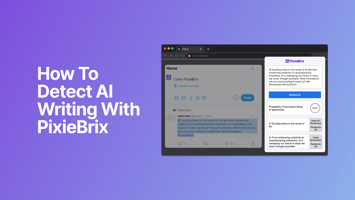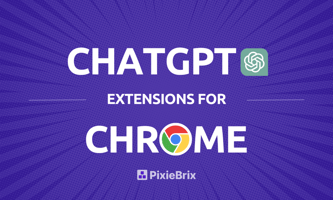Let's face it. AI can be pretty daunting (read: terrifying). Artificial Intelligence is evolving...
What Are The Best AI Detectors?
In recent years, the rise of AI-generated content has been staggering. For instance, OpenAI's GPT-3 can produce text so human-like that it has been used to write news articles, social media posts, and even entire books. In fact, a study revealed that 38% of readers couldn't distinguish between content written by AI and that by humans.
- During the 2023 Met Gala, two viral AI-generated images of Katy Perry (who wasn’t at the event) looked so realistic that her mom mistakenly thought the singer was in attendance.
- Bad Bunny slammed an AI soundalike that went viral on TikTok.
- AI-generated images of the Pope went viral after he was captured in a clean puffer.
:format(webp)/cdn.vox-cdn.com/uploads/chorus_asset/file/24539414/ai_pope_drip_god.jpg)
Detecting AI-generated content is becoming crucial as artificial intelligence continues to grow and integrate itself into various aspects of our daily lives. With AI's ability to produce highly realistic text, images, and even videos, the risk of misinformation and deception grows. AI-generated content can be used to create fake news, manipulate public opinion, and even commit fraud, posing severe ethical and security challenges. In academia and professional settings, distinguishing between human and AI-generated work is essential to uphold integrity and accountability. In a landscape where trust is paramount, reliable AI detectors help maintain the authenticity of information, ensuring that what we read, see, and believe is genuine and accurate.
Understanding AI Detectors
AI detectors, also known as AI writing detectors, AI text detectors, or AI content detectors, are designed to identify when a piece of content (text, media, images, etc.) has been partially or wholly created by artificial intelligence systems like ChatGPT.
AI-generated content comes in several forms, each with its own unique characteristics and implications:
- Text: AI tools like GPT-3 and GPT-4 can generate human-like copy for use in many formats, including articles, essays, reports, and social. These AI platforms can produce content that mimics human writing styles and can be used for a multitude of purposes, like pumping out sales emails in Gmail, trying to go viral on X, or writing outbound messages on LinkedIn.
- Images: Create highly realistic, believable images from text prompts. AI tools like DALL-E and Stable Diffusion can create highly realistic images from textual descriptions or even generate entirely new artwork. Tools like DALL-E or Stable Diffusion can be used for everything from designing marketing materials to creating art.
- Deepfakes: Highly convincing fake videos or audio recordings that manipulate real, existing footage and/or sound using AI. Deepfakes can be used to create misleading or harmful content, such as fabricated news reports or fraudulent videos, posing significant risks for misinformation and privacy breaches.
- Audio: AI can generate synthetic voices or mimic real voices with high accuracy. This technology is used for creating voiceovers, synthesizing speech for accessibility purposes, or even generating realistic-sounding conversations. However, it also has potential for misuse in creating fraudulent voice messages or misleading audio content.
- Synthetic Data: AI can generate synthetic datasets used for training other AI models. While this can help in developing algorithms and conducting research, it can also be used to create fabricated data that may mislead analysis or skew results in various applications.
Did you know there is a Chrome extension that allows you to check for AI-generated content on any webpage? It's called PixieBrix and it's a free AI Detector.
Key Features of AI Detectors
- Accuracy: Accuracy is key. What's the point of a detector if it's inaccurate? An effective AI detector is built on its ability to accurately identify AI-generated content. This involves recognizing subtle patterns and anomalies in the text or media that indicate it was created by an AI system.
- Speed: Speed kills. Detectors should be able to process content quickly to provide real-time or near-real-time results. This is especially important in scenarios where timely verification is crucial, such as in newsrooms or during live content moderation. This is likely the reason we see so many people get duped by AI-generated articles.
- User-Friendliness: The detector should have an intuitive, easy-to-use interface, allowing the use to query content and get instant results without technical expertise. You should be able to either input the specific copy into a search function and get the results or highlight them directly on the page and get the results in a sidebar.

- Adaptability: How adaptable is the AI detector? Any tool worth its weight should be able to handle a wide range of AI-generated content, including text, images, audio, videos.
- Transparency: Don't just trust any tool. The tool should provide clear explanations and detailed reports on why a particular piece of content was flagged as AI-generated. The majority of reliable AI detectors provide in-depth info on the results.
- Integration: The detector should be capable of integrating with existing systems and workflows, such as content management platforms, social media channels, or academic integrity systems, to streamline its use and enhance its effectiveness.
- Customizability: The ability to customize detection parameters or thresholds based on specific needs or contexts can be crucial. For example, different industries or applications may require tailored detection settings to address unique challenges.
- Scalability: The tool should be able to handle varying volumes of content, from small batches to large-scale operations, without compromising performance. Scalability is important for organizations with diverse and high-volume content needs.
Top AI Detectors in the Market
PixieBrix
PixieBrix leverages the power of AI and automation to harness the latest technology to streamline your workflows and take your productivity to new heights. PixieBrix is a Chrome extension that works where you work. Our AI text detector integrates with GPTZero to quickly analyze and classify whether specific text was written by AI. All you need to do is highlight text, click the 🤖, and our sidebar will display a full rundown highlighting whether the document was AI-generated.
Turnitin
Turnitin, a widely recognized leader in academic integrity, has expanded its capabilities by integrating AI detection tools into its platform. This innovative move is particularly crucial in an era where AI-generated content is becoming more prevalent. Turnitin AI detector is designed to identify text that may have been produced or heavily influenced by artificial intelligence, ensuring that the originality of student work remains intact. By leveraging advanced algorithms and machine learning, Turnitin not only detects plagiarism but also differentiates between human-written and AI-generated content, providing educators with a robust tool to maintain academic standards. This enhancement reflects Turnitin's commitment to staying ahead of technological advancements, making it an indispensable resource for educators and institutions striving to uphold academic honesty.

TraceGPT
TraceGPT's AI checker uses advanced technologies against text generators to catch AI-related breadcrumbs. The algorithms analyze various parameters, including creativity/predictability ratio, to detect AI content across different AI bots. This AI detector provides "97% accurate results, avoiding False Positive when human writing is recognized as an AI-generated document."

Winston AI Detector
Winston AI calls itself "the only AI detector with a 99.98% accuracy rate." Winston helps check AI content generated with ChatGPT, GPT-4, Google Gemini and many more Large Language Models.

Winston Key Features
- AI Detector: Detect Al content made with the most advanced Al writing tools such as ChatGPT, Google Gemini, Claude and much more.
- AI Image Detection: Detect Images and Deepfakes generated with Midjourney, DALL-E, Stable diffusion and more. This means if you're worried about someone use Remaker AI, you can detect those AI images.
- Advanced Plagiarism Checker: Ensure the originality of your content with a cutting-edge plagiarism detection technology.
- Readability Score Checker: The free readability checker will analyse your content and provide you with a reading ease assessment score.
Hive
The Hive Moderation AI-generated content detection tool is part of Hive's automated content moderation tools. It can also detect AI-generated images, videos, and audio.

The AI-Generated Content Detection tool is designed to detect content generated by AI language models. The detector analyzes various linguistic patterns, coherence, and other attributes to determine the likelihood that a piece of text was generated by AI. Hive's model processes the inputs in order to determine whether or not they are AI-generated. On top of an overall score, the results include which engine created an image and which segment of text has the most artificial content.
Originality.AI
Originality.AI is a dual-function tool for detecting plagiarism and AI-generated content, tailored for web publishers, content creators, and SEO professionals. It ensures high standards of content originality, essential for maintaining credibility and avoiding search engine penalties. Originality.ai uses AI to offer a suite of product: AI checker, Plagiarism Checker, Fact Checker, Readability Checker, and Site Scan to help writers and businesses publish accurate, easy-to-read content.

- AI Checker: AI Checker is a specialized tool within the Originality.AI platform designed to detect content generated by artificial intelligence. It evaluates text to determine if it has been produced by AI language models, such as GPT-3, by analyzing various linguistic patterns and characteristics unique to AI-generated content. This helps content creators, publishers, and SEO professionals ensure that their content is original and not artificially generated, maintaining high standards of authenticity and integrity.
- Plagiarism Checker: Plagiarism Checker is a tool designed to identify and prevent plagiarism in digital content. It is tailored for web publishers, content creators, and SEO professionals to ensure that their work is original and not copied from existing sources. This tool compares the submitted content against a vast database of online material to detect any instances of plagiarism. By using this checker, users can maintain high standards of content integrity, which is crucial for credibility and avoiding penalties from search engines.
- Fact Checker: Fact Checker is designed to verify the accuracy of information in written content. It aims to ensure that the facts presented in articles, blog posts, and other types of content are correct and reliable. By cross-referencing data with credible sources, the fact checker helps content creators and publishers maintain high standards of accuracy and trustworthiness in their work. This is particularly important for maintaining credibility, avoiding misinformation, and ensuring compliance with search engine guidelines and ethical publishing standards.
- Readability Checker: Readability Checker is a feature that assesses the readability of written content. It evaluates text based on various metrics and readability formulas to determine how easily a reader can understand the content. This tool is beneficial for content creators, web publishers, and SEO professionals to ensure their writing is accessible and engaging for their target audience. By improving readability, users can enhance the overall user experience and potentially improve their content's performance in search engine rankings.
- Site Scan: Site Scan is a feature that allows users to scan an entire website for plagiarism and AI-generated content. Comprehensive Scanning examines all the content on a website, identifying instances of plagiarism and AI-generated text. Automated Monitoring regularly monitors websites to ensure ongoing content originality and compliance with originality standards. Detailed Reports highlight which parts of the website's content are plagiarized or AI-generated, making it easier to address any issues.
Undetectable AI
Undetectable AI is a writing tool designed to rewrite AI-generated content to bypass content detectors. Simply copy and paste your text into the editor, and it will reprocess it using new words, structures, and phrasing.
Undetectable.ai is an essential rewriting tool to detect and humanize your AI text from ChatGPT, Jasper, Copy.AI and similar AI tools into completely human-like content that avoids AI detectors. With Undetectable, you can:
- Bypass the most advanced AI detectors on the market.
- Create human-like, keyword-rich content that ranks high on search engines.
- Ensure your emails and SEO content won't be flagged as spam.
- Express your originality and creativity without the constraints of AI detection.

Scribbr
Scribbr’s AI Detector accurately detects texts generated by the most popular tools, like ChatGPT, Gemini, and Copilot. It also offers advanced features, such as differentiation between human-written, AI-generated, and AI-refined content and paragraph-level feedback for more detailed analysis of your writing.
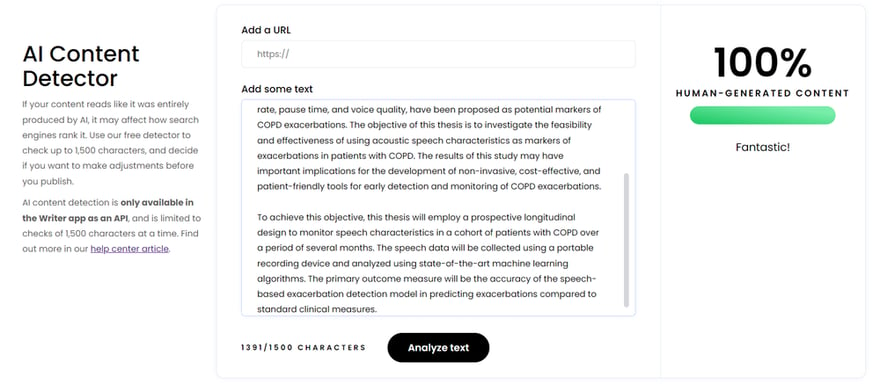
Authority on AI and plagiarism
Scribbr plagiarism and AI detector tools and helpful content are used by millions of users every month.
Advanced algorithms
Scribbr AI checker is built using advanced algorithms for detecting AI-generated content. It’s also been enhanced to distinguish between human-written, AI-generated, and AI-refined writing.
Unlimited free AI checks
Perform an unlimited number of AI checks for free, with a limit of up to 1,200 words per submission, ensuring all of your work is authentic.
Paraphrasing detection
Scribbr’s AI Detector provides insight into whether a piece of writing is fully AI-generated, AI-refined, or completely human-written.
Multilingual support
Scribbr AI Detector supports multiple languages, including German, French, and Spanish.
Paragraph level feedback
Scribbr AI Detector identifies specific areas in your text that are likely AI-generated or AI-refined, to provide a detailed analysis of the content.
Sapling AI Content Detector
Sapling AI Detector is an artificial intelligence tool designed to detect and analyze the usage of AI-generated text. It is typically used by educators, content creators, and businesses to identify content that may not have been created by a human, ensuring integrity and authenticity in writing.
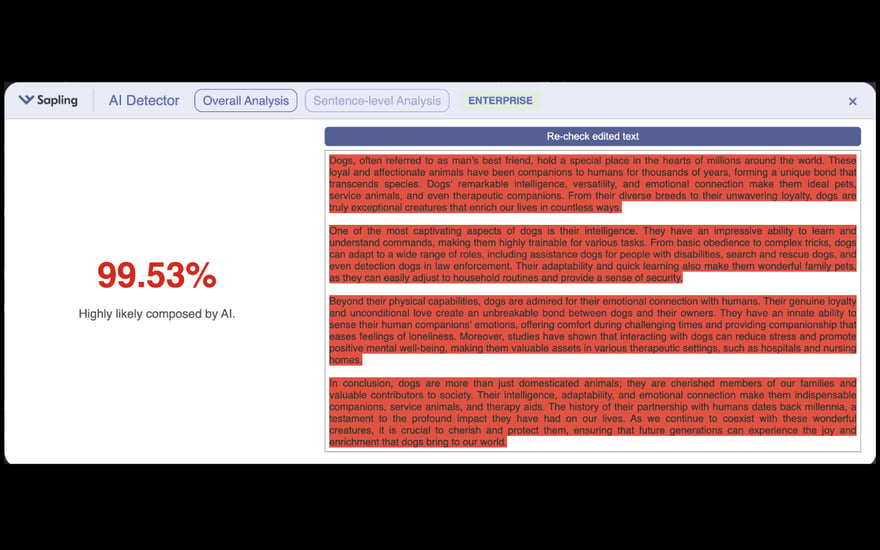
Key features:
- Detection score: Returns a probability score of whether a text has been AI-generated or not. It can interact with models like ChatGPT, Gemini, and Claude. It flags text generated through artificial intelligence or at a sentence level.
- Metadata File Support: Upload PDFs and DOCX files to detect AI content. The solution also has API access which is great for automated and large-spectrum content checks.
- Extension: It's a browser extension added to enable the ability to check AI-generated content with every webpage, in addition to the ability to hook in with chatbots like ChatGPT.
Quillbot AI Detector
QuillBot is an AI-powered paraphrasing tool that also includes its own integrated AI content detection software. The platform provides a variety of tools, such as a paraphraser, grammar checker, plagiarism detector, summarizer, and citation generator. This article will concentrate specifically on QuillBot's AI detection capabilities.
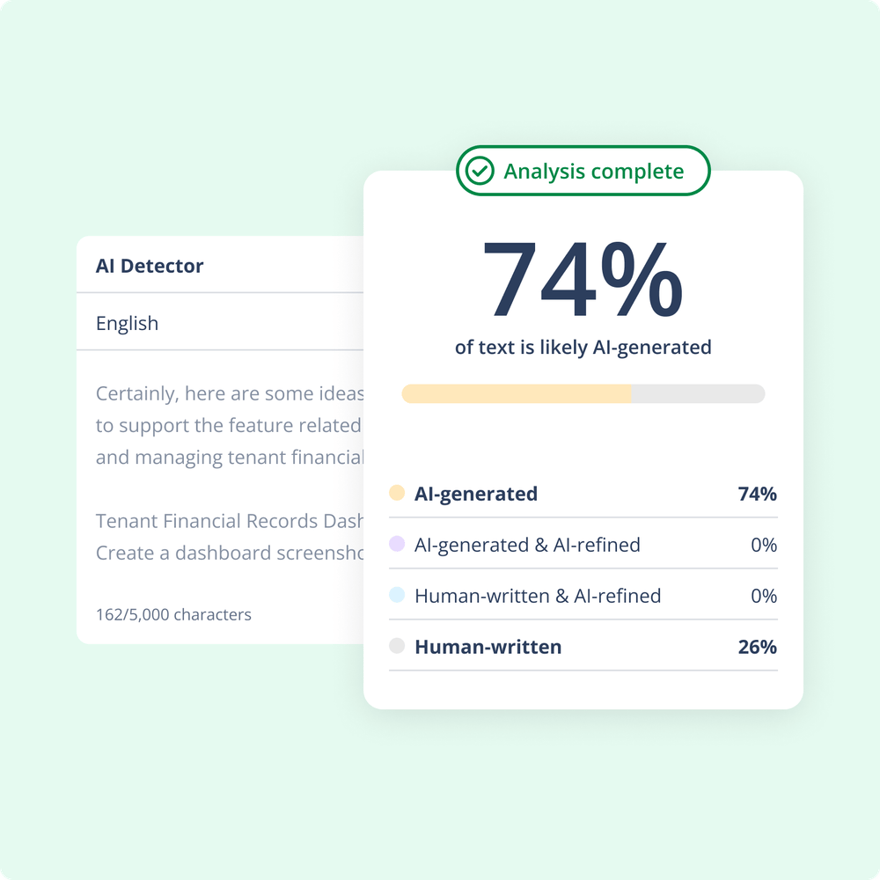
Key features:
- Scan unlimited documents at no cost to you.
- Analyze blogs, papers, projects, and more.
- Pinpoint exactly which text is ai-generated.
- Instant reports.
Copyleaks AI Detector Tool
The Copyleaks AI detection tool boasts an impressive accuracy rate of over 99%. It supports more than 30 languages and keeps up with the latest advancements by covering GPT, Gemini, Claude, and newer models as they arrive.
Copyleaks AI checker is designed to recognize human writing patterns, making it easy to use and effective. When it detects deviations from these patterns or specific AI signals, it flags the text as potentially AI-generated. Copyleaks has tested over 1 million texts and achieved an impressive false positive rate of just 0.2%.
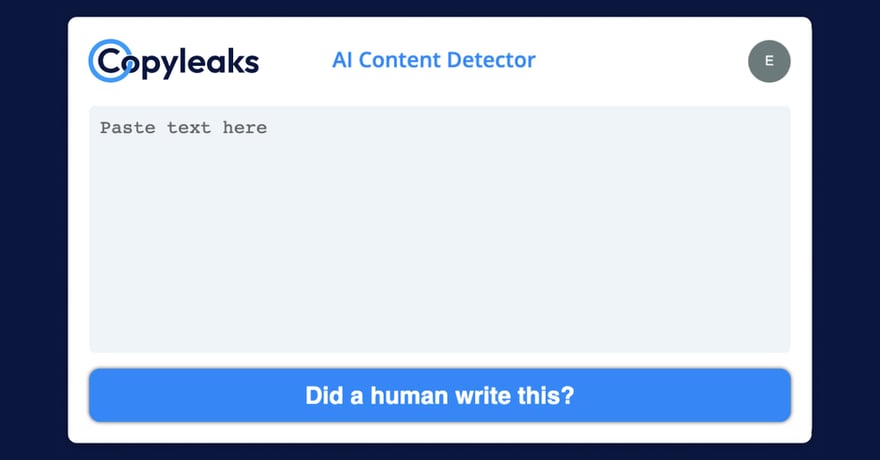
Key features:
- Complete AI Model Coverage: Go beyond a simple ChatGPT detector—get detection for all AI models, including Gemini, Claude, and any new models as they are released.
- Unprecedented Accuracy: Copyleaks AI Detector boasts over 99% accuracy and an industry-low false positive rate of just 0.2%.
- Plagiarism and Paraphrased AI Detection: Have full visibility of your content, identifying potential plagiarism or paraphrasing within AI-generated text.
- AI-generated Source Code Detection: Copyleaks thoroughly scans AI-generated code for potential issues, including licensing violations and security vulnerabilities.
- Detect Interspersed AI Content: The Copyleaks AI text detector can accurately spot AI-generated text, even when it’s carefully mixed with human writing.
- Military-Grade Security: All Copyleaks products boast military-grade security, GDPR compliance, and SOC 2 and SOC 3 certification.
Identifying AI-Generated Content
Here are a few key elements to explore when trying to analyze whether what you're reading was written by a human or by AI.
- Lack of emotion: While AI can be great at handling certain tasks, like answering questions on the fly or summarizing text, it can struggle with conveying emotions and personality. This can make the text feel bland and uninteresting. Writers might utilize undetectable ai to humanize their ChatGPT-generated content or ai paraphrasing tools, but those tools tend to go heavy on the human and light on the content.
- Repetition: When you plug in a prompt to ChatGPT's language processing AI and it spits out your paragraph, blog, thesis etc. it will likely end up sounding super repetitive, utilizing similar language and phrasing over and over. It can become very apparent as you read deeper and deeper into the piece. They end up using the same words and phrases over and over and over. Just stuck in the same pattern. Like right now. With humans, the writing is more varied as we tend to adjust our writing in that exact moment or go back and make edits. Looking for repetition is a key component in detecting AI text generation and AI content creation.
- Errors: This is a tough one and definitely more difficult to gauge whether it's a human error or just AI failing to grasp grammar, spelling, or punctuation. I'm sure I made some grammatical errors earlier in this blog, whether I forgot to drop in "are" after "there" or Grammarly just didn't catch something (though that's unlikely). A good way to gauge whether AI had written a specific piece is to refer to the author's past work and check out the grammar and punctuation to see if there's a trend that had changed recently.
- Context: As we said earlier, AI continues to evolve and grow but there are still major limitations. AI is relatively 1:1 at the moment. Meaning you drop in a prompt and it spits out your request. Human-curated content will have contextual clues and details that possibly refer to previous mentions in the content or even current events. AI cannot generate the same level of complexity and depth that humans can.
In a rapidly evolving digital landscape, finding the best detector de IA is crucial for maintaining integrity and ensuring the authenticity of content. Whether you're a student, educator, or professional, tools like the Turnitin AI detector and Scribbr AI detector provide powerful solutions for identifying AI-generated content. These platforms are invaluable for anyone needing an AI detector for essays, or even an AI writing detector to scrutinize academic work for AI involvement. For those looking for an AI detector free of charge, options like the Grammarly AI detector and Quillbot AI detector offer accessible alternatives, making it easier than ever to ensure content authenticity without breaking the bank.
While chatgpt detectors offer a valuable tool for discerning human-generated content from AI-produced text, their effectiveness is dependent on various factors. It's essential to approach these tools with a critical eye, considering factors like detector accuracy, evolving AI capabilities, and the specific context of the text being analyzed. By understanding the limitations and strengths of chatgpt ai detectors, users can make informed decisions about their reliability and potential applications.
The range of AI detector tools available today extends beyond just text, with AI image detectors and AI code detectors providing specialized solutions for various needs. For example, the Winston AI detector and Copyleaks AI content detector stand out as robust tools for professionals seeking to maintain high standards in content creation. As AI continues to shape the future, having reliable AI-generated text detectors and AI generator detectors is essential for combating misuse. From the academic sphere to content creation and beyond, these tools are not just optional—they're necessary for upholding the quality and integrity of digital work.
PixieBrix detector de IA es una herramienta diseñada para identificar y analizar contenido generado por inteligencia artificial. El detector de plagio IA permite verificar la originalidad de los textos al comparar con una base de datos extensa. El detector de IA gratis ofrece acceso a estas capacidades sin costo alguno.
